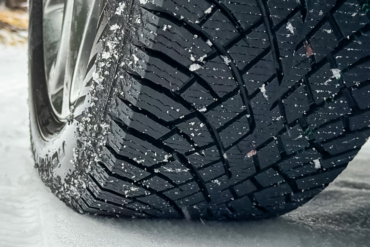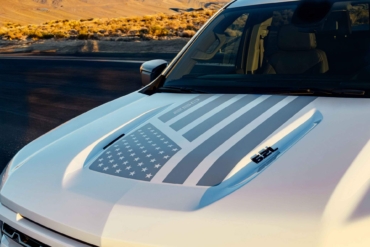When facing a wall of possible contenders, you scan through a variety of full-face, modular, open-face, and half-helmets. You may even notice the choice of race, touring, road, dual-sport, and dirt helmets.
Look a little closer, and your decision becomes even more daunting. Notice that the shells of the helmets are made up of different materials, and the helmets have various safety ratings like DOT, ECE, Snell, and FIM.
Before you reach for the Tylenol, let me put your mind at ease as I break all of this down.
Helmet Types
All approved motorcycle helmets are designed to protect your head, but not all helmets are created equally.
While they share similar features, such as a hard outer shell, an energy-absorbing liner, a comfort liner, and a chin strap to keep the helmet on your head, you may notice that some helmets cover more of your head than others.
Full-Face Motorcycle Helmet

Walk into any motorcycle helmet dealer, and you will see a wide selection of full-face helmets. They are by far the most popular motorcycle helmet type. The full-face helmet is also the safest of all helmet types. A helmet can only protect the areas of your head it covers, after all.
All full-face helmets cover your entire head, including your chin, except for a wide opening that allows you to see your surroundings. Within this category of helmets, there are several sub-categories.
Road Full-Face Motorcycle Helmet

As the name suggests, this helmet is most suited for road use. Its aerodynamics are great for riding at speed and offer excellent protection from the wind and rain. It also offers a variety of opening and closing vents for increased airflow and fog resistance.
Many comfort features are available within this sub-category, including retractable sun visors, communication systems, and chin bar skirts that prevent unwanted airflow from entering the underside of the helmet.
Race Full-Face Motorcycle Helmet

A race helmet looks similar to its road counterparts and shares many of the same features. A race helmet can certainly be used on the road, but it may omit some comfort features, such as opening/closing vents. The eye-port may be slightly raised to allow for a racer’s riding position, and it may be a lot more expensive than a road helmet due to the materials used in its shell and its certifications.
Dirt/Moto X Full-Face Motorcycle Helmet

A dirt helmet is designed and built for use off-road. It includes a peak (like a baseball cap) to protect the rider from the sun and debris and has an extended chin guard for ventilation. Unlike road helmets, these helmet types don’t include a visor. To protect the eyes, riders will wear goggles. A dedicated dirt helmet will provide more ventilation than a street or dual-sport helmet. This is particularly important when riding the trails at lower speeds. Dirt helmets are typically lighter too, which is easier on your neck when bouncing around off-road.
Dual-Sport Full-Face Motorcycle Helmet

When the road helmet met the dirt helmet, a dual-sport helmet was born. These helmets have comforts similar to a road helmet but offer practicality when venturing off-road. They are a great option for riders who want to ride both on- and off-road without buying two dedicated helmets.
You may find that some dual-sport helmets include features that suit the road more, while others favor off-road. When considering a dual-sport helmet, decide what type of riding you will be doing the most so that you choose one best suited to your needs.
Modular Motorcycle Helmet

Modular helmets look very similar to full-face helmets and can offer the same features. There is one major difference. The chin bar can flip up and effectively give you an open-face helmet feel.
This is particularly useful if you are riding in groups and would like to chat with one another without being impeded by a chin bar. You can eat or drink at rest stops or fill up with fuel without taking your helmet off.
This feature makes the modular helmet particularly attractive to touring riders. You may also choose to ride with the chin bar up at low speeds (for increased ventilation) and down at higher speeds.
But be aware that not all modular helmets are approved for riding with the chin bar up, so you will need to check if you intend to use your modular helmet that way.
Open-Face Motorcycle Helmet

An open-face helmet, as the name suggests, does not include a chin bar. Like anything, they have their pros and cons.
The open-face helmet offers the same benefits as a modular helmet with the chin bar up, with possibly even more airflow. You can even get them with great designs that pair well with your café racer, cruiser, or scooter.
They may also come with a flip-down sun visor to eliminate the need for goggles. Some three-quarter helmets even come with removable chin guards (that may or may not be safety approved).
The downside of an open-face helmet is that without a solid chin guard, like that in a full-face helmet, your face is left vulnerable in the event of an accident and/or flying road debris. It will likely also be noisier than a closed helmet.
Dome Helmet/Skull Cap Motorcycle Helmet

Particularly popular with cruiser riders, the dome helmet is more about ‘the look’ than protection. They offer the bare minimum of protection as they cover only the top of a rider’s head. Some skull cap helmets do include drop-down sun visors.
For more information on helmet types, take a look at my Motorcycle Helmet Types Explained video.
Motorcycle Helmet Construction
The aim of any approved motorcycle helmet is to protect your head in the event of an accident. Regardless of which type of helmet you choose, its construction is made up of a hard outer shell, a crushable foam liner (EPS liner), a comfort liner, and a chin strap. Most helmets also include a visor.
Shell
The shell is the first thing you see when you look at a motorcycle helmet. It is the hard exterior of the helmet that will take the brunt of an impact. There are a number of materials that can be used to create a helmet shell, and each of them is safe and effective. The main difference between each type is the material’s behavior on impact.
I have broken down shell construction into three main types of shell construction: polycarbonate, composite, and carbon fiber.
Polycarbonate
Polycarbonate is an impact and penetration-resistant thermoplastic that performs well in low-speed impacts.
In constructing the shell, the polycarbonate is heated up and shaped in a mold and can be quickly mass-produced.
Manufacturers of polycarbonate shells may only produce a few shell sizes per model to keep the overall cost of the helmet down. To provide a wide range of fitment, greater or smaller amounts of padding are used.
While polycarbonate is not intended to flex or dent, it is susceptible to abrasion. This means that more material is required in its creation than other types of shells. As a result, the polycarbonate helmet tends to be heavier. A polycarbonate shell can also produce more noise than other shell types.
Composite
Composite helmets can be made up of a range of combined materials, including fiberglass, carbon fiber, and Kevlar. The composite materials are woven together in several layers before being molded into shape. The result is a strong and flexible outer shell that is lighter than polycarbonate.
Composite helmets are a great middle ground between polycarbonate and carbon fiber helmets, and the price of the helmets will reflect that.
Carbon Fiber
Carbon fiber shells are strong and lightweight. The shell has the benefit of being able to disperse energy across itself in the event of an accident, therefore offering better overall protection than polycarbonate or composite shells.
The material doesn’t offer additional noise reduction, so carbon fiber helmets are typically as noisy as composite helmets.
A shell that is 100% carbon fiber will tend to have a higher price than composite or polycarbonate shells.
Motorcycle Helmet Liners
EPS Liner

The EPS (expanded polystyrene) layer is the next layer of protection in your motorcycle helmet. It is the crushable foam layer that sits between the shell and the comfort layer. The role of the EPS liner is to absorb and disseminate the energy of an impact by crushing under pressure.
Budget helmets that offer a limited range of shell sizes will typically produce standard thicknesses in their EPS liners across the range. It is then the comfort liner that determines the helmet fitment. On higher-end helmets that offer a wider range of shell sizes, it is the EPS liner that will be adapted to different thicknesses.
Comfort Liner

The next layer is the one you see on the inside of your helmet when you put it on. This layer is all about comfort and getting that snug fit. Take a look at my How to Fit Your Motorcycle Helmet Right video for more information.
Many helmets have removable and washable comfort liners, which is a great feature to keep your helmet smelling and looking fresh.
Comfort liners also come in a wide range of fabrics that are breathable, odor-resistant, moisture-wicking, hypoallergenic, bacterial and fungal-resistant, and so forth. These may be overlooked features but may play an important part in your decision to purchase one helmet over another.
Motorcycle Helmet Chin Straps

The chin strap is a crucial element in keeping your helmet in place in the event of an accident. The nylon strap is durable and resistant to various temperatures and conditions. The difference comes with the closure that connects the two straps.
The first of the closures is the double D-ring fastener. The double D-rings are strong and reliable. While they may be fiddly for new riders, they will quickly get used to the system. The second is the micrometric fastener. This fastener is often found on modular helmets for ease of use, but there are no hard and fast rules.
They are both safe options, so the decision might just come down to preference or what the helmet you choose comes with. There is no hard and fast rule regarding which fastener goes with which helmet type, except for racing helmets which require the double D-ring fastener.
Motorcycle Helmet Visors

As mentioned earlier, not all helmets have a visor, but most do. Typically helmet visors are made from polycarbonate and offer durability and flexibility. Budget helmets may include acrylic visors. Acrylic visors tend to be more brittle and less scratch resistant.
There are a number of features related to visors that may influence your decision to purchase one helmet over another. These include the sun visor, Pinlock (or other anti-fog systems), and photochromatic visors.
Sun Visor

Sun visors are integrated within the front of the helmet, allowing you to move them down in front of your eyes (akin to putting on sunglasses) or retract them back inside the helmet when you no longer need them. Things to consider about sun visors:
Where is the slider positioned? The mechanism for sliding the sun visor up and down can be in various positions on the helmet. Try opening and closing the visor with the helmet on to find a position that is comfortable for you to use. If it’s not easy to use, you are less likely to use that feature.
How far does it drop down? There is no set distance a sun visor will drop down. While checking where the slider is positioned, check how far the sun visor comes down. Does it come down too far, or not far enough? Or is it just right?
How dark is the sun visor? With the sun visor down, take a look outside at the daylight. Is the sun visor too dark or too light for your needs, or do you feel comfortable with it?
Does it have UV protection? This information isn’t always available but may be worth looking out for, especially if you spend a lot of time on your bike.
Pinlock and Anti-Fog Systems
Helmet visors tend to fog up in cool or wet weather when your warm breath meets the cool visor. There are various solutions to this problem, the most popular of which is the Pinlock system.

This system uses flexible transparent plastic inserts, which are placed on the inner surface of your visor and effectively act as double-glazing for your visor. Visors must be Pinlock-ready to use this system. However, many helmet brands support the Pinlock system and provide Pinlock-ready visors.
Some helmets will also come with a Pinlock insert in the box. Pinlock is not the only solution to the fogging problem. It is worth checking if your helmet visor comes with an anti-fog solution.
Photochromic Visors
An alternative to a drop-down visor is the photochromatic visor. These visors darken or lighten automatically depending on the amount of UV light hitting them. While not as common as drop-down visors, photochromatic visors are increasingly being fitted in new helmets.
Motorcycle Helmet Safety Ratings

There is no single global motorcycle helmet standard, but there are a number of common helmet standards you may see on a helmet if you live in the U.S. These include DOT, ECE, Snell, and FIM. Each standard focuses on impact testing in slightly different ways at various locations on the helmet. To receive a pass, a helmet must meet a minimum benchmark.
Helmets can be tested and receive a pass for more than one standard, but since all motorcycle helmets sold in the U.S. are required to meet the DOT standard, let’s start there.
DOT

Regardless of any other standard that a helmet meets, all motorcycle helmets sold in the U.S. are required to meet the DOT standard, first and foremost, to be legal. There are four tests that a helmet must pass to qualify for DOT certification: an impact test, a penetration test, a retention strap test, and a peripheral vision test.
While these tests are not easy to pass, the standards are more lenient than the following motorcycle helmet standards.
DOT-approved helmets include a sticker at the rear of the helmet that will include the manufacturer/brand name, the helmet model number, DOT, and FMVSS No.218 Certified.
ECE
This is the standard set by the Economic Commission for Europe. The ECE certification is the most widely accepted motorcycle helmet standard worldwide, and it is used in nearly 50 countries worldwide.
The current ECE standard is ECE 22.05; however, you may see ECE 22.06 stickers on the back of helmets as the ECE 22.06 standard will supersede the current 22.05 standard in January 2024. Under ECE 22.06, helmets are put through rigorous testing to ensure they provide greater protection.
Helmets are tested not only for impact resistance, rigidity, friction, chin-strap strength, and retention but also for environmental influences such as temperatures, ultraviolet light, humidity, and moisture. Approved ECE helmets have a label sewn onto the chin strap. You may also see a sticker on the back of a helmet with either ECE 22.05 or ECE 22.06 and the helmet’s weight.
Snell

Snell is an independent, third-party, non-profit helmet standard and testing organization based in California. It is not required by any jurisdiction that a helmet has Snell approval.
However, helmet manufacturers may pay to have their DOT or ECE-approved helmets further tested by Snell. Snell claims that helmets that pass their tests have the highest protection.
Snell-certified helmets have a certification label under the comfort padding. All helmets approved by Snell are listed on the Snell website.
FIM
FIM is a European safety certification for motorcycle racing and is also the newest of the four certifications mentioned here. The organization performs additional tests on helmets that are already certified by ECE, Snell, or JIS (Japanese safety standards).
Of all certifying bodies, FIM performs the most rigorous testing. As an organization concerned with racing, only full-faced helmets with double-D ring fasteners are tested.
FIM-approved helmets have a QR code sewn onto the chinstrap. A list of FIM-approved helmets can be found on the FIM Racing Homologation Programme website.
Motorcycle Helmet Pricing

When you have shortlisted a selection of helmets that meet your needs, you may find a significant price difference between them. Depending on the type of helmet you are looking for and your criteria for selecting one, you could pay anywhere from $50 to more than $4,000. So why such a variation in prices?
First, while helmets in-store meet the DOT or ECE standards (depending on where you purchased the helmet), there is nothing that tells you if the helmet only just met the minimum safety requirements or if it exceeded them by a long shot. The additional safety a helmet provides could impact the price.
Next, the materials used in the helmet can influence the price significantly. More expensive helmets will often have more expensive materials in their construction. A higher price may also mean that more shell sizes are available in a particular helmet model. More shell sizes mean you won’t look like Dark Helmet from the 1987 comedy Spaceballs.
Also, safety standards don’t measure comfort levels. A budget helmet will still be safe, but it may skimp on quality ventilation, the type of material used in its comfort lining, sun visor, chin skirts, and anti-fog systems. You get the idea.
Finally, when it comes to motorcycle helmets, double the price doesn’t necessarily mean double the safety. Including features in a helmet can affect the helmet’s structure. So more testing is required, which can lead to higher prices.
Choosing the right motorcycle helmet for you may not be straightforward. But armed with this information, you can narrow down the field a lot easier and avoid the disappointment of buying a helmet that doesn’t suit your needs.
For further information on choosing a motorcycle helmet, watch my How to Choose the Right Motorcycle Helmet video below.








